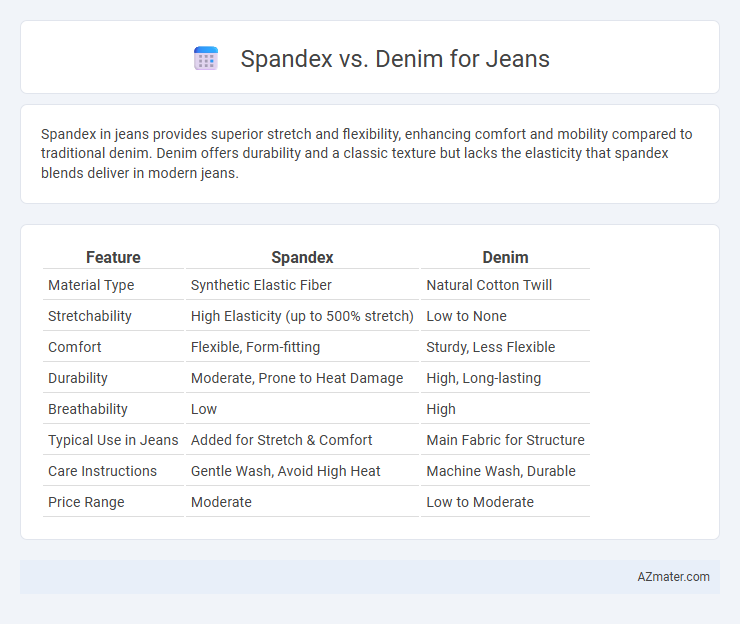Spandex in jeans provides superior stretch and flexibility, enhancing comfort and mobility compared to traditional denim. Denim offers durability and a classic texture but lacks the elasticity that spandex blends deliver in modern jeans.
Table of Comparison
| Feature | Spandex | Denim |
|---|---|---|
| Material Type | Synthetic Elastic Fiber | Natural Cotton Twill |
| Stretchability | High Elasticity (up to 500% stretch) | Low to None |
| Comfort | Flexible, Form-fitting | Sturdy, Less Flexible |
| Durability | Moderate, Prone to Heat Damage | High, Long-lasting |
| Breathability | Low | High |
| Typical Use in Jeans | Added for Stretch & Comfort | Main Fabric for Structure |
| Care Instructions | Gentle Wash, Avoid High Heat | Machine Wash, Durable |
| Price Range | Moderate | Low to Moderate |
Introduction to Spandex and Denim in Jeans
Spandex is a synthetic fiber known for its exceptional elasticity, often blended with cotton to create stretchable jeans that offer enhanced comfort and flexibility. Denim, a sturdy cotton twill fabric, has traditionally been used in jeans for its durability and classic rugged look. The incorporation of spandex into denim transforms the traditional rigid fabric into a more form-fitting, comfortable garment suitable for everyday wear.
Fabric Composition: Spandex vs Denim
Spandex in jeans typically consists of 1-5% elastane blended with cotton, providing stretch and flexibility for enhanced comfort and fit. Denim, traditionally made from 100% cotton, offers durability and a classic sturdy texture but lacks inherent stretchiness. The fabric composition difference impacts the jeans' flexibility, making spandex-blended denim ideal for active wear versus rigid, pure cotton denim for structured, long-lasting garments.
Comfort and Flexibility Comparison
Spandex-infused jeans offer superior comfort and flexibility due to the elastic fibers that allow for greater stretch and freedom of movement compared to traditional denim. Denim jeans, made primarily from cotton, provide durability but lack the same level of stretch, often feeling more rigid and restrictive during activities requiring flexibility. Incorporating spandex enhances the fit and softness of jeans, making them ideal for active wearers seeking a blend of style and comfort.
Durability and Longevity Differences
Spandex-infused jeans offer exceptional stretch and comfort but typically compromise durability compared to traditional denim, which is woven from 100% cotton fibers known for their strength and longevity. Denim jeans, especially those made with heavyweight cotton, resist wear and tear over extended use, making them ideal for rugged environments. While spandex blends provide flexibility, they tend to lose elasticity with frequent washing, resulting in reduced lifespan relative to classic denim.
Breathability and Moisture Control
Spandex-infused jeans offer superior stretch and flexibility but typically have lower breathability compared to 100% denim, which is made from cotton fibers allowing better air circulation. Denim excels in moisture absorption and wicks sweat away from the skin, enhancing moisture control during wear. However, spandex blends may trap heat and moisture, making denim jeans more suitable for breathability and comfort in warmer conditions.
Style and Fit: Which Fabric Wins?
Spandex-infused jeans provide superior stretch and flexibility, offering a snug, body-hugging fit that enhances comfort and movement, ideal for those seeking a modern, sleek silhouette. Denim, especially pure cotton varieties, delivers a classic, structured appearance with a firmer fit that molds over time, appealing to enthusiasts of traditional, rugged style. For style and fit, spandex wins for flexibility and contemporary appeal, while denim excels in durability and timeless fashion.
Maintenance and Care Requirements
Spandex-infused jeans require gentle washing in cold water and air drying to maintain elasticity and prevent fabric damage, whereas denim jeans tolerate more robust washing but benefit from avoiding frequent machine washes to preserve color and texture. Stretch denim blends with spandex need less ironing compared to 100% cotton denim, which often requires higher heat settings. Proper care tailored to the fabric composition extends garment longevity and ensures comfort retention in both spandex and traditional denim jeans.
Environmental Impact of Spandex and Denim
Spandex production relies heavily on non-renewable petrochemicals and generates significant greenhouse gas emissions, raising concerns about its environmental footprint in jean manufacturing. Denim, typically made from cotton, involves extensive water usage and pesticide application, contributing to soil degradation and water pollution, though organic cotton options mitigate some impacts. Both materials pose sustainability challenges, but innovations in recycling and eco-friendly production methods are essential to reduce the environmental impact of spandex and denim jeans.
Price Differences and Value for Money
Spandex-infused jeans typically cost more than traditional denim due to the added stretch technology enhancing comfort and flexibility. Denim jeans, often priced lower, provide durability and a classic look but lack the elasticity that spandex blends offer. Consumers seeking value for money weigh the higher price of spandex jeans against their superior fit and prolonged wearability compared to regular denim.
Choosing the Right Jeans: Spandex or Denim?
Spandex-infused jeans offer superior stretch and comfort, making them ideal for active wear and a flexible fit, while traditional denim provides durability and a classic look favored for long-lasting wear. When choosing between spandex and denim jeans, consider lifestyle needs: spandex blends suit dynamic movement and body contouring, whereas pure denim excels in ruggedness and timeless style. Prioritizing fabric composition, fit, and intended use ensures selecting jeans that balance elasticity with strength for optimal everyday performance.

Infographic: Spandex vs Denim for Jean
 azmater.com
azmater.com